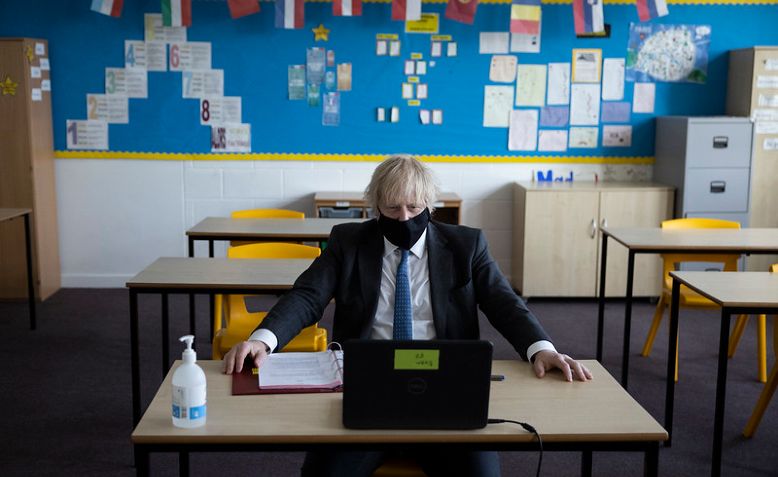 Boris Johnson visits Sedgehill Academy/ Photo: Simon Dawson / cropped from original / licenced under CC 2.0 linked at bottom of article
Boris Johnson visits Sedgehill Academy/ Photo: Simon Dawson / cropped from original / licenced under CC 2.0 linked at bottom of article
Despite the bluster over ‘data not dates’ there are big holes in the prime minister’s ‘irreversible’ plan argues Terina Hine
We have a newly cautious Prime Minister, we have a roadmap, and we are apparently being driven by data not dates.
So has the government finally understood the need for caution – even if a year late?
The latest SAGE modelling tells us that “a sudden lifting of many measures in the near future could lead to a wave of hospitalisations larger than the one we’ve just seen,” that a fourth wave – even with vaccinations – could risk a doubling of the death toll.
So the easing of lockdown will be in stages – with five-week gaps between each new measure being lifted. Data leading us all the way.
Strikingly the one thing the government’s published roadmap lacks is data; but there are plenty of dates. Dates for visiting family, opening each sector of the economy and of course for going on holiday.
There are four tests, but they are vague and unquantified, using phrases such as “sufficiently effective” and “unsustainable pressure” with no explanation as what is sufficient or unsustainable.
The roadmap is supposed to be England wide, but what happens if the north has declining case numbers while the south has rising numbers or a surge in hospitalisations – or vice versa?
With Tory backbenchers pushing hard for relaxation to go further faster, how immovable will the government’s dates actually be? And if regional case numbers vary how national will the lifting of restrictions remain?
The Covid Recovery Group of Tory MPs are calling for the government to be clearer about the data to speed things up; others have asked for the same to ensure the opening doesn’t go too fast. Without figures or numbers to measure progress, how will anyone know if progress is adequate?
For all its talk of data over dates the government’s roadmap offers a list of dates with no data. It is inevitable that the dates will lead the way whatever the soundbite.
And what about the promise to keep the famous R number below 1? If R is above 1 the virus grows exponentially. With the big bang approach to the reopening of schools and millions returning to poorly ventilated classrooms – talking and breathing indoors – keeping R below 1 is unlikely if not impossible. We know that the main means of transmission is though airborne particles, yet our classrooms remain poorly ventilated and most schools remain crowded.
Epidemiologist and SAGE member Dr Mike Tildsley has publicly stated that the return of schools will push the R to above or very close to 1. Even if R remains under 1 it will not be by much – at best cases will continue to decline but at a much slower rate than they are now. The hope is that the vaccination programme will prevent this leading to hospitalisations and death. But a spreading virus is ripe for mutation.
The current dominant strain of the virus is 70% more transmittable than the one we had last spring. Hundreds are still dying each day. Among the “vaccinated groups” there will be a large minority who go unvaccinated. And we have only limited evidence as to the extent vaccines impact transmission.
The SAGE papers show that even with vaccine induced reduction in transmutability “there could still be a resurgence if control measures are relaxed.” If cases start to rise again in March, even if not accompanied by hospitalisations and deaths thanks to the vaccine, the risk of a new vaccine resistant variant emerging will rise with them.
Over 130,000 have died of Covid-19 under the watch of the Johnson government. We have been living under restrictions for a year – and are all desperate to be released, but can we really afford to take any more chances?
The Tories refuse to learn lessons from abroad – Johnson used his speech on Monday to denounce a zero-Covid strategy despite its success in Australia, New Zealand and a host of far east countries. They have refused, again, to provide support for isolation.
SAGE says: The “relaxation of a significant number of restrictions over 3 months starting from the beginning of April could lead to hospital occupancy higher than the January peak whereas relaxation over 9 months would result in a much smaller peak.”
Yet unlocking over a period of 3 months is exactly what we are doing. Johnson continues to leave all his eggs in the vaccine basket, and his vague criteria allows far too much room for botching the exit from lockdown yet again with no long term preparations in sight.

